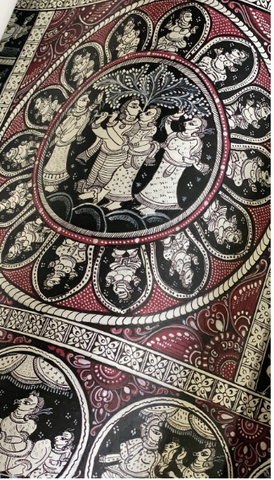
Pattachitra, meaning "picture on cloth" in Sanskrit, transcends the mundane definition of art. It's a window into the vibrant tapestry of Indian culture, a whispered echo of forgotten myths, and a testament to the enduring artistry of generations past. For centuries, these cloth-based, handmade, and palm-leaf scrolls have served as more than mere decorations; they've been educators, storytellers, and keepers of faith, carrying within their vibrant hues the essence of a land rich in mythology and folklore.
Born in the eastern provinces of Odisha and West Bengal, Pattachitra boasts a lineage that stretches back a millennia. Its roots lie in the ritualistic practices of ancient temples, where deities were worshipped through visual narratives woven on cloth. With time, this sacred art form blossomed into a vibrant expression of everyday life, depicting epics like Ramayana and Mahabharata, and celebrating local legends with an unbridled exuberance of colour and form.
In villages like Raghurajpur and Naya Village, families pass down the skills of this craft through generations, meticulously preparing natural pigments, wielding fine brushes with practised hands, and infusing each stroke with the spirit of their heritage.
"Pattachitra is not just painting; it's breathing life into stories." - Manoranjan Chitrakar, Bengal Pattachitra artist.
A Tapestry of Styles and Techniques in Pattachitra
Pattachitra is much more than a singular style. It's a vibrant tapestry woven from diverse regional variations, each boasting its own unique flavour and artistic language. Let's embark on a journey to explore some of the most prominent styles within this captivating art form:
1. Odisha Pattachitra:
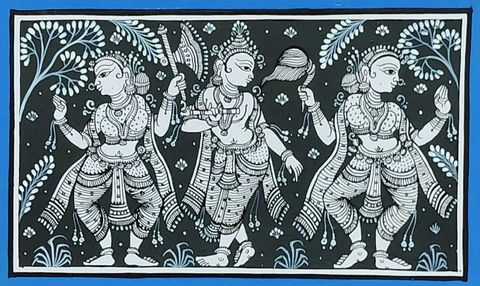
Orrisa Pattachitra
In the land of Jagannath ji, Odisha Pattachitra explodes in a symphony of bold colours and intricate details. Divine figures with elongated eyes dance across the canvas, and mythical creatures adorn temple chariots, their forms woven from stories of the Puranas in swirling patterns. Crafted with natural pigments coaxed from minerals, plants, and seashells, these vibrant narratives come alive on cotton or silk canvases, prepared with a time-honoured paste of stone powder and tamarind gum. Fine squirrel hair brushes become an artist's voice, meticulously painting scenes from Jagannath and Vaishnava lore. While the core themes remain, the art evolves, embracing accessibility with the occasional use of synthetic pigments and even modern themes like environmental issues. Witnessing an Odisha Pattachitra is like stepping into a vibrant tapestry of faith and beauty, woven with devotion and meticulous artistry.
2. Tala Pattachitra:
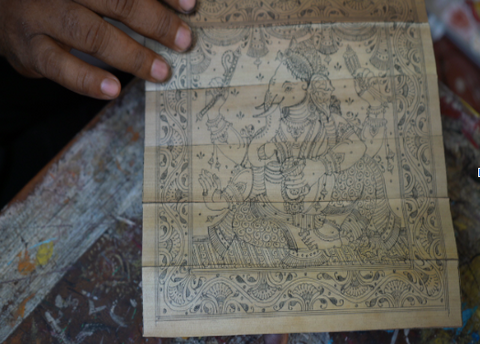
Talapatra
Now, let's venture into the heart of Odisha and discover the unique charm of Tala Pattachitra. Here, the canvas shifts from cloth to dried palm leaves that are stitched together, offering a delicate and textured surface for the artist's brush. The themes, too, take a turn, depicting deities from local folklore, the Hindu pantheon, and vibrant stories passed down through generations. Witness the fierce goddess Mangala, the whimsical tales of Barabati, and the intricate patterns echoing the rhythms of tribal life. Tala Pattachitra is a whisper of ancient secrets, etched onto the very pulse of the land.
3. Bengal Pattachitra:
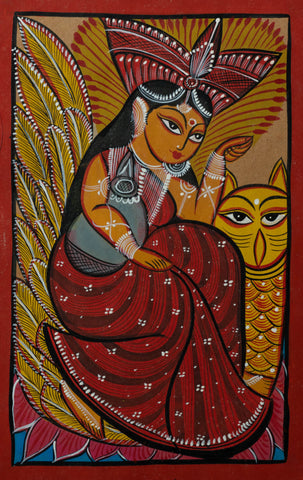
Goddess Lakshmi with Owl in Bengal Pattachitra
Stepping into West Bengal, we encounter a style of Pattachitra that revels in the art of storytelling. Unlike its Odia counterpart, its canvas is often handmade paper with fabric glued at the back. Here, the canvas dances with vibrant hues, often derived from natural sources like earth pigments and vegetable dyes. Themes, while still encompassing Hindu mythology, also embrace local folktales and everyday scenes. You can witness boatmen navigating turbulent rivers, village festivals bursting with life, depicting various forms of goddess Durga, and Rama and Sita whispering secrets under the shade of a mango tree.
The magic doesn't stop at brushstrokes. Patuas, the gifted Chitrakars (artists), become storytellers themselves. Their voices weave Pater Gaan, songs that breathe life into the painted narratives, transforming the static tableau into a dynamic performance.

Modern themes and social commentary, influenced by artists like Jamini Roy, have also found their way into this art form, breathing new life into its ancient soul. Bengal Pattachitra isn't just an art; it's a universe where sight, sound dance, and myths mingle with reality.
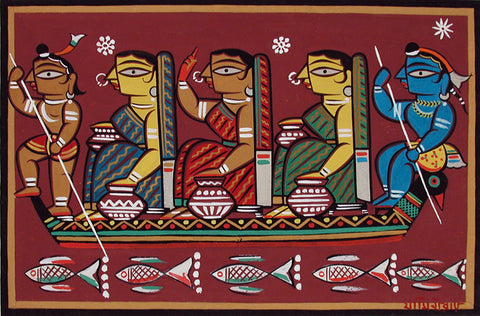
Boating by Jamini Roy
4. Kalighat Pattachitra:
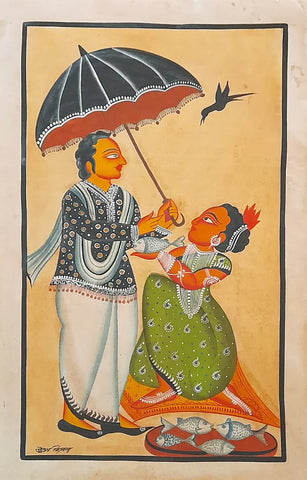
Kalighat Pattachitra
In the urban centres of West Bengal, we encounter a fascinating offshoot: Kalighat Pattachitra. This style, while rooted in traditional Bengal Pattachitra, underwent a unique evolution during the British Raj. Influenced by Western artistic ideas and social realism, Kalighat Pattachitra began depicting contemporary themes, social commentary, and everyday life alongside mythological narratives. You can witness the satirical caricatures of colonial figures, poignant vignettes of rural life, and the evolving spirit of Indian art finding expression on the canvas of Pattachitra.
5. Santhal Pattachitra:
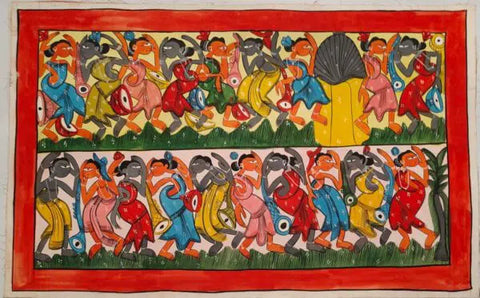
Santhal Pattachitra
Finally, we journey to the vibrant world of Santhal Pattachitra, a style born from the rich artistic heritage of the Santhal tribe, located majorly in the areas of Purulia and Bankura. Characterised by bold geometric patterns, stylized figures, and earthy tones, Santhal Pattachitra depicts scenes from tribal life, nature worship, and ancestral spirits. The depictions of bondeya (forest spirits), often with animal heads and human bodies, symbolising protectors and guides. The majestic honko birin (horned bird) is believed to carry messages between the living and the ancestors, and the fearsome ban bhoot (forest ghost) serves as a guardian of sacred spaces. Witness hunting expeditions captured in rhythmic lines, the reverence for nature etched in every stroke, and the vibrant spirit of a distinct community come alive on cloth.
Exploring the Distinctive Threads of Pattachitra
Every brushstroke in a Pattachitra whispers a prayer, a hope, a secret passed down through generations.
While the term "Pattachitra" may paint a broad picture of cloth-based scroll paintings, each regional style within this art form boasts its own unique characteristics. Let's unravel some of the key differences that set these styles apart:
Odisha Pattachitra vs. Bengal Pattachitra:
- Odisha Pattachitra is renowned for its meticulous attention to detail, evident in the fine lines and elegant borders that frame its intricate scenes. In contrast, Bengal Pattachitra tends towards bolder lines and thicker borders, adding a touch of whimsy and exuberance to its storytelling.
Bengal Pattachitra vs. Kalighat Pattachitra:
- Kalighat Pattachitra incorporated Western artistic techniques and social realism, resulting in bold brushstrokes and a distinct style. Traditional mythological narratives were juxtaposed with contemporary themes like social commentary, the Babu-Biwi series(also known as Babu Pat in Bengal), satire, and historical events, creating a dynamic and politically aware art form.
Regional and Tribal Distinctions:
- The tribal art form of the Santhal community showcases its unique identity, depicting scenes of everyday life like hunting expeditions. Santhal Pattachitra also delves into the vibrant spirit world.
- Tala Pattachitra whispers secrets on a distinct canvas: dried palm leaves. Unlike cloth, its grooves dance with carved tales, not painted hues. Artists use special tools to create delicate lines and shapes on the leaves, telling tales of local gods and old legends.
A Closing Hymn to Pattachitra
In a world starved of colour, Pattachitra is a feast for the soul. Its vibrant pulse paints everyday life with the spirit of India. Pattachitra's dazzling beauty lies in its true depth. It's a vibrant bridge between past and present, whispering ancient tales, and sustaining generations through art. These canvases aren't decorations; they're cultural tapestries, economic lifelines, and windows into the soul of India.
For many families in India, Pattachitra is not just an art form; it's a way of life. These families not only sustain themselves through Pattachitra but also contribute to the vibrant economy of their communities, showcasing their unique skills and cultural heritage to the world. By appreciating this art form, we not only admire its aesthetics but also engage in a dialogue with the past, present, and future of a vibrant culture.
References
“Type of Indian Art - Pattachitra.” RtistiQ. Accessed January 23, 2024. https://art.rtistiq.com/en-us/blog/type-of-indian-art-pattachitra#:~:text=Styles,its%20intricate%20patterns%20and%20designs.
WorldArtCommunity.com. “The Story of Pattachitra Craft.” - Stories From Our World, June 9, 2022. https://www.worldartcommunity.com/blog/2022/05/the-story-of-pattachitra/.
Sen, Rupsha. “Patachitra Paintings – A Spiritual Endeavor.” Caleidoscope, December 13, 2022. https://www.caleidoscope.in/art-culture/patachitra-paintings.
Koparesh. “Two Types of Pattachitra Paintings.” Medium, November 21, 2022. https://medium.com/@koparesh10/two-types-of-pattachitra-paintings-88c72993b8a6.
Tiwari , Shruti. Painter of Gods - An indigenous technique of Pattachitra with reference to contemporization of local cultural heritage, 2023.
Artopia, Posted. “A Poetry Called Pattachitra.” Artopia, October 4, 2020. https://artopiabyasha.wordpress.com/2020/10/04/a-poetry-called-pattachitra/.






















